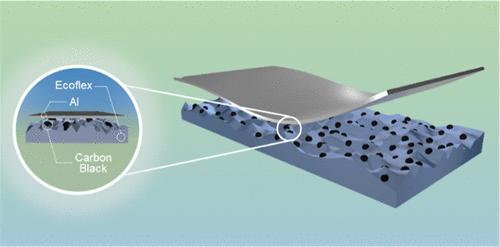基于天然Al2O3纳米电介质的医疗保健和机器人三重不灵敏度柔性传感器
IF 8.2
2区 材料科学
Q1 MATERIALS SCIENCE, MULTIDISCIPLINARY
引用次数: 0
摘要
柔性压力传感器对于电子皮肤和人机交互等先进系统至关重要。其中,离子电容式压力传感器以其优异的柔韧性和灵敏度引起了广泛的关注。然而,环境温度、湿度和工作电路频率的变化会显著降低离子电容压力传感器的测量精度,并增加后续信号处理的复杂性。本文提出了一种基于Al-Al2O3-CB接口的电容结构,在100 kHz-1 MHz范围内实现了温度不敏感(- 5°C - 45°C)、湿度不敏感(20% RH - 80% RH)和频率不敏感(波动率<;3%),同时保持了高灵敏度(24.62 kPa-1)和快速响应和恢复时间(33 ms/16 ms),该设计可以大大降低传感器系统的电路校准复杂性。该传感器的性能已在各种应用场景中得到验证,包括生理信号监测、手势识别和机器人触觉传感。传感器系统通过进一步集成通信电子模块,提供基于手部运动感知的轮椅控制,为肌肉无力和其他特殊需要的患者提供更大的可及性和便利性。本文章由计算机程序翻译,如有差异,请以英文原文为准。

Natural Al2O3 Nanodielectric-Based Flexible Sensor with Triple Insensitivity for Healthcare and Robotics
Flexible pressure sensors are critical for advanced systems such as electronic skins and human–machine interaction. Among them, ionic capacitive pressure sensors have attracted widespread attention due to their exceptional flexibility and sensitivity. However, variations in ambient temperature, humidity, and operating circuit frequency significantly degrade the measurement accuracy of ionic capacitive pressure sensors and increase the complexity of subsequent signal processing. This paper proposes a capacitor structure based on the Al–Al2O3–CB interface, which achieves temperature insensitivity (−5 °C–45 °C), humidity insensitivity (20% RH–80% RH), and frequency insensitivity (volatility <3% within the range of 100 kHz–1 MHz), while maintaining high sensitivity (24.62 kPa–1) and fast response and recovery time (33 ms/16 ms), and this design can substantially reduce circuit calibration complexity for sensor systems. The sensor’s performance has been validated in various application scenarios, including physiological signal monitoring, gesture recognition, and robotic tactile sensing. By further integrating communication electronic modules, the sensor system offers wheelchair control based on hand movement perception, providing enhanced accessibility and convenience for patients with muscular weakness and other special needs.
求助全文
通过发布文献求助,成功后即可免费获取论文全文。
去求助
来源期刊

ACS Applied Materials & Interfaces
工程技术-材料科学:综合
CiteScore
16.00
自引率
6.30%
发文量
4978
审稿时长
1.8 months
期刊介绍:
ACS Applied Materials & Interfaces is a leading interdisciplinary journal that brings together chemists, engineers, physicists, and biologists to explore the development and utilization of newly-discovered materials and interfacial processes for specific applications. Our journal has experienced remarkable growth since its establishment in 2009, both in terms of the number of articles published and the impact of the research showcased. We are proud to foster a truly global community, with the majority of published articles originating from outside the United States, reflecting the rapid growth of applied research worldwide.
 求助内容:
求助内容: 应助结果提醒方式:
应助结果提醒方式:


